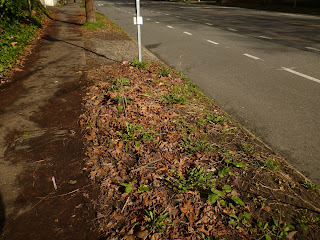< Bus Stop Biosphere II | Bus Stop Biosphere IV >
Find 1: We seem to have a period once or twice a year that we get a series of cold nights in Seattle. These nights are best when followed by a bright, sunny day where you can view your plants with a coating of ice crystal, a soft rime?
January 2013: Front Yard - on a crisp morning. Plants with ice. Geranium x cantabrigiense - 'Biokovo' and Thuja occidentalis leaf.

Find 2: These pictures show evidence of the work of a Northern Flicker (bird) (Colaptes auratus). We have a couple in our neighborhood and they are amusing to watch as they pull dirt, moss, and plants out of cracks looking for food (insects, beetles, snails). Flickers are part of the woodpecker family (Picidae), but unlike woodpeckers frequently feed on the ground. Not until writing this did I realize we have had many less snails in our yard, perhaps due to the flickers?
February 2013: Cement Cracks Back Alley. Northern Flicker (Colaptes auratus) handiwork.
Find 3: It always amazes me to lift up a leaf on cement or asphalt and find worms.
February 2013: Back Alley. Worms.
Find4: It’s February and a sunny day to boot. Time for a dandelion (Taraxacum) to unfurl its flowers?
February 2013: Fremont Ave bus stop. Dandelion (Taraxacum).

Find 5: One of the test subject areas for bus stop biosphere.
February 2013: Fremont Ave bus stop. Patch of ground.
Find 6: An over-wintered leaf of Himalayan Blackberry (Rubus armeniacus syn. Rubus discolor) tinge burgundy-brown. From the King County Noxious Weed web site. “Himalayan and evergreen blackberry are European species of blackberry that are highly invasive and difficult to control. Originally introduced for fruit production, they are now naturalized and widespread throughout the Pacific Northwest. They are easy to spot by their large, vigorous, thicket-forming growth and sharp spines covering the stems.” They didn’t mention the burgundy-brown color of the leaves.
February 2013: Fremont Ave bus stop. Last year’s blackberry leaf.

No comments:
Post a Comment
All comments are moderated. If your comment doesn't appear right away, it was likely accepted. Check back in a day if you asked a question.